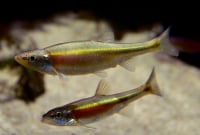Support strong Canadian climate journalism for 2025
Experts say the new federal recovery strategy for an endangered tiny minnow shows building Ontario Premier Doug Ford’s promised Highway 413 would be illegal. The federal government released the strategy in July, 15 years after listing the redside dace as a species at risk. It mandates a habitat protection order within 180 days, which will intensify scrutiny of the highway project’s overlap with critical redside dace habitats.
“Because that habitat overlaps so much with the proposed 413 route, and because paving nearby land or altering stream flows are specifically identified as ‘likely’ to destroy redside dace habitat, this means that most 413-related construction activities, and much of the highway itself, would be illegal going forward,” said Phil Pothen, who works on land use for Environmental Defence.
Highway 413 would, if constructed, cut through 2,000 acres of farmland, cross 85 waterways, and pave over nearly 400 acres of protected Greenbelt land. This would directly impact 220 wetlands and disrupt the habitats of 10 species at risk, including the redside dace.
But Ford remains defiant in the face of these concerns. Asked in a Tuesday press conference about the redside dace recovery strategy and its implications for Highway 413, Ford dismissed the notion that the project would significantly impact the species.
“We live in 1,070,000 square kilometres. I just want to get their philosophy on species at risk — how do they measure it?” Ford said. “Just imagine, 1,070,000 square kilometres, and we're taking a little strip for transportation. So someone needs to explain it to me.”
Ford said he remains optimistic about the highway’s chances.
“We're going to work collaboratively with the federal government,” Ford said. “We always work collaboratively with the Minister of Environment when it comes to species at risk.”
The Impact Assessment Agency of Canada told Canada's National Observer the governments of Canada and Ontario have signed a memorandum of understanding to establish a joint federal-provincial working group. This group will assess the effects of Highway 413 on federally listed species at risk, including the redside dace, and work to identify measures to avoid, lessen, or mitigate these impacts.
But Pothen says the new redside dace recovery strategy reinforces the need for an independent federal impact assessment of Highway 413. He notes that Canada's Constitution designates inland fish species as a federal responsibility, and the strategy highlights that the highway's proposal would severely affect these fish.
Pothen hopes that the timing of the recovery strategy’s release — after years of delays, at a critical time for the highway — means Canada will pause Highway 413 for a full impact assessment.
According to Environmental Defence, the highway would destroy over 65 per cent of the species' remaining habitat, pushing it closer to extinction.
Evan Sambasivam used to work for DFO, which is responsible for the fish — and says he played a key role in the recovery strategy during his time with the government.
Now running for the Toronto city council, Sambasivam expressed doubts about the feasibility of the project given the environmental constraints.
“You can imagine that having a highway run through the 137 creeks in which the redside dace lives could have a pretty profoundly negative impact on the fish,” Sambasivam said. “They would have to do so without disrupting any of its habitat at all. It’s quite a high bar, one that the province is not currently capable of clearing. They’re years away from even the most basic permits.”
Sambasivam told Canada’s National Observer the redside dace, which leaps from the water to eat insects like mosquitoes, depends on both clean waterways and the nearby marshlands and forests. These surrounding areas are essential for its food supply and overall survival. “The Ford government has not shown how it would be possible to prevent impact.”
According to Ontario Nature, nearly 90 per cent of the redside dace population in Ontario can be found in the Greater Toronto and Hamilton area, encompassing the Credit and Humber rivers — both of which would be intersected by Highway 413.
Donald Jackson, a professor in the University of Toronto's Department of Ecology who specializes in the structure and composition of fish communities in lakes and streams, also expressed serious concerns about the potential impact of the highway on the redside dace and its habitat.
Jackson told Canada's National Observer that the fish needs cool, clean water to survive and is highly sensitive to environmental changes. He noted that the species cannot tolerate elevated temperatures, high contaminants, or silt from construction activities.
“It's a good indicator of water quality in that sense, and it has these requirements,” Jackson said.
Jackson said that one of the critical factors in maintaining suitable conditions for the redside dace is the presence of groundwater. Groundwater helps keep streams cool during the summer.
Jackson warns that the construction process itself could have immediate and long-term detrimental effects on the redside dace habitat. During construction, large areas of land are disturbed, vegetation is removed, and soil is exposed. This disruption can lead to increased runoff during rain events, which carries silt and other materials into nearby streams. Runoff from construction sites can also alter the natural flow and temperature of water in streams. This can raise water temperatures beyond what the redside dace can tolerate.
According to Jackson, even after construction is complete, the presence of a new highway can continue to impact the habitat. Paved surfaces prevent water from soaking into the ground, reducing the recharge of groundwater that is essential for maintaining cool stream temperatures. Instead, rainwater runs off the highway, carrying with it contaminants such as road salt in winter. This runoff can lead to higher chloride levels in streams, which are harmful to aquatic organisms.
Jackson also criticized Ford’s remarks on species at risk, noting that the premier seemed to lack understanding of the importance of their protection. Jackson argued that Ford’s perspective ignores that the redside dace and other species have occupied these specific habitats for thousands of years. The development of cities and infrastructure in these areas has already placed significant pressure on them, and construction of Highway 413 could push them closer to extinction.
A 2020 report from Ontario highlighted that the redside dace population has dropped by over 50 per cent in the past decade, with much of its remaining habitat now slated for development.
With files from Natasha Bulowski
This story has been updated to clarify Evan Sambasivam’s role at DFO.






Comments
The only thing Doug "The Thug" Ford cares about along the 413 route that his corrupt developer donors get their pork barrels filled. There are no bounds to Ford's corruption, especially given no one wants another highway and the extent of the destruction it will bring, just so his buddies can line their pockets.
Road salt is not the only contaminant leaking into the environment; wear and tear of tires leaves tons of rubber, toxic chemicals and plastic particules (estimated at around 10 pounds per capita in the US) along the roads. Coho salmon populations in BC and western coastal US have been impacted by chemicals from tires leaking into streams. Very fine particules coming from wear and tear of tires not only contaminate water but also the air we breathe. They can enter your bloodstream and seriously affect your health (The Guardian, Feb 23, 2023: "Health impact of tyre particule causing increasing concern...").